Rivers and the Water Cycle
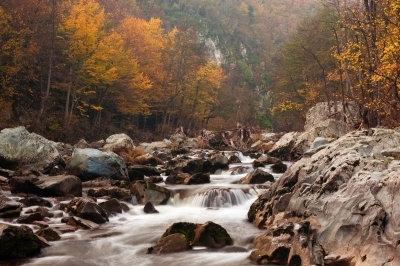 When it rains, some water soaks into the ground and some of it collects, forming streams and rivers that eventually flow into the sea. The water that falls as rain is constantly recycled because water can change from a liquid to a gas (a process known as evaporation) and back to a liquid again (condensation). The water from rivers, seas and oceans is turned into water vapour by the sun’s heat and by the wind. This vapour rises up into the sky and the cold air there makes the vapour condense into droplets and form clouds. These droplets grow bigger and heavier until they eventually fall as rain. This continuous movement of water is called the water cycle.
When it rains, some water soaks into the ground and some of it collects, forming streams and rivers that eventually flow into the sea. The water that falls as rain is constantly recycled because water can change from a liquid to a gas (a process known as evaporation) and back to a liquid again (condensation). The water from rivers, seas and oceans is turned into water vapour by the sun’s heat and by the wind. This vapour rises up into the sky and the cold air there makes the vapour condense into droplets and form clouds. These droplets grow bigger and heavier until they eventually fall as rain. This continuous movement of water is called the water cycle.
Three quarters of planet earth’s surface is covered by salt water – the seas and oceans. The quarter of the surface which is land holds more water – this is fresh and will be found in rivers, lakes or underground.
 A river is therefore a very important part of the water cycle, carrying rain water back to the sea. It can be a long journey for a raindrop. Rivers can run for many hundreds of miles. The longest river in the world is the Nile in Africa. It is 6,700km long. The longest river in Britain is the River Severn, which is 354km long.
A river is therefore a very important part of the water cycle, carrying rain water back to the sea. It can be a long journey for a raindrop. Rivers can run for many hundreds of miles. The longest river in the world is the Nile in Africa. It is 6,700km long. The longest river in Britain is the River Severn, which is 354km long.
Of course, not all the water flowing down the rivers is returned to the sea straight away. Some of the water that we use in our homes, schools, shops, offices, factories etc. comes from rivers. When we use water we remove it from the natural water cycle and return it to rivers via sewage treatment systems. This is a manmade cycle.
How does a river start?
Most rivers begin their life high up in the mountains and hills of the world. There are heavy downpours of rain here and perhaps melting snow. Some of the rain soaks into the ground and the rest runs over the surface, collects in pools, then trickles downhill with the force of gravity. Small streams are formed, which get bigger as they collect more water and join up with other streams. The ever-increasing stream wears away the ground as it goes, carving out valleys and shaping the landscape. The speed of the flowing water and the hardness of the ground have an effect on the shape created. The ‘wearing away’ is called erosion.
A mountain stream is sometimes called a youthful river and it is fast flowing, making deep valleys with steep sides. Once it begins to cut a valley it is trapped in it and will continue to carve out the same valley for perhaps thousands of years. As it tumbles downhill, the stream collects and carries rocks, stones and pebbles along with it. Progressing on its journey towards the sea, it collects more and more water until it is big enough to be called a river. Eventually, the land becomes flatter and the water flow slows down, causing the river to drop its stones and pebbles onto the river bed. This is called deposition. As an ‘old river’ meanders slowly through flat land (a bend in a river is called a meander), it is carrying only mud.
Where does a river end?
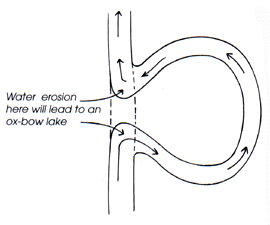 Eventually a river meets the sea and the place where it does is called the mouth. The last of the mud is deposited at the river’s mouth. A wide mouth is called an estuary. Some estuaries are enormous – the estuary of the Amazon is 333 kilometres wide!
Eventually a river meets the sea and the place where it does is called the mouth. The last of the mud is deposited at the river’s mouth. A wide mouth is called an estuary. Some estuaries are enormous – the estuary of the Amazon is 333 kilometres wide!
Sometimes a lowland river winds so much that the looping meanders almost touch. The river may eventually erode away the narrow area of land between two loops so that its course runs straight and a horseshoe-shaped area of water is stranded – an ox-bow lake.
Types of river
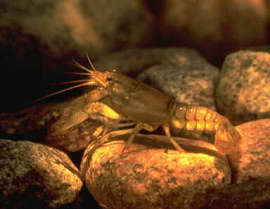 Generally speaking, in Britain you can find three main types of river;
Generally speaking, in Britain you can find three main types of river;
- with both upland and lowland sections
- with upland sections only and flowing mainly westerly
- flowing only in lowland, found in the south and east of Britain.
Within these geographical areas, there is a variety of types which are determined by the type of rocks the river is flowing over. Along its route, the water in a river may pass over several different types of substrate (the rock below it); clay, sandstone, chalk, soft or hard limestone. Each kind of rock has an influence on both the water and the species of animals and plants that live there.
For example, the freshwater crayfish, a large crustacean, needs water with plenty of oxygen and a good supply of lime in the water to help build up its thick, outer skeleton; a fast flowing river running over chalk is ideal for this particular animal. A gravel-bottomed stretch of river will have a different group of plants to a stretch with a silted clay bottom.
Humans Influence on Rivers
Rivers are part of human’s culture. Thousands of years ago, early humans settled by lowland rivers and later used them for transport from one settlement to another, and for power to drive flour mills and other machinery. Our larger rivers, such as the Thames and the Severn, were used by large industrial boats and, as a result, stretches of the rivers had to be dredged deeply to maintain a deep channel. This prevented any natural development of the river bottom. Today, much of this industrial traffic has disappeared only to be replaced by pleasure boats. The larger boats still need the deeper channels and smaller craft require the removal of water plants, thus reducing habitat for wildlife. The wash from fast motorized boats erodes the river banks, floods the nests of animals and washes away wildlife.
A lowland river left in its natural state bursts its banks every year and floods the surrounding area. To prevent this from happening, the meandering rivers have been straightened over the years, their banks reinforced to stop erosion, and the submerged plants cut back or removed. The demands of our modern-day society for hydro-electric power, irrigation, fishing, boating etc, means that river management is essential.
One of the most important aspects of management is the careful monitoring of water quality, which is carried out by the frequent sampling of water and testing for impurities. This is to keep a check on perhaps the most dangerous of all of our effects on rivers... Pollution!
 For hundreds of years we got rid of our waste into rivers and streams, but it was the growth of the industrial revolution during the nineteenth century that resulted in the rivers suffering the greatest pollution they have ever known. By the middle of the 1800s, the Thames was so polluted with raw human sewage that the stench was overpowering! Several epidemics of cholera broke out, causing much human suffering, and, of course, the effect on the river’s wildlife was devastating. The last record of a salmon was in 1833 and by the 1950s, the only fish left was the eel. Since then, a serious clean-up campaign has enabled even the salmon to return to the Thames. Strict bye-laws now control the discharge of effluent (waste discharged from a particular process) by riverside industry but modern development still presents problems. Every year, up to 11,000 tonnes of rubbish are collected from the Thames!
For hundreds of years we got rid of our waste into rivers and streams, but it was the growth of the industrial revolution during the nineteenth century that resulted in the rivers suffering the greatest pollution they have ever known. By the middle of the 1800s, the Thames was so polluted with raw human sewage that the stench was overpowering! Several epidemics of cholera broke out, causing much human suffering, and, of course, the effect on the river’s wildlife was devastating. The last record of a salmon was in 1833 and by the 1950s, the only fish left was the eel. Since then, a serious clean-up campaign has enabled even the salmon to return to the Thames. Strict bye-laws now control the discharge of effluent (waste discharged from a particular process) by riverside industry but modern development still presents problems. Every year, up to 11,000 tonnes of rubbish are collected from the Thames!
The following things can be the source of types of river pollution;
- sewage
- chemicals and other waste from industry
- oil
- pesticides and fertilisers
- litter
- detergents from households and workplaces
- large amounts of hot water
- animal waste (slurry)
- dense or decaying plant growth
The Environment Agency (EA) keeps an eye on the rivers and tries to prevent people causing pollution. It is against the law to cause any type of water pollution. Whereas many types of pollution have been recognised and reduced, we have too be careful that others do not become worse. One of the biggest problems today is eutrophication i.e. the natural growth of water plants, especially algae, is speeded up by the presence of an unnatural abundance of nutrients, supplied by certain effluents (such as artificial fertilizers); when these plants die and decay, the bacteria acting on the decaying material use up so much oxygen that little is left for other water life. The rapid plant growth also blocks out the sunlight, which results in the death of underwater plant and animal life.
Why Britain's rivers are at risk
Water is used for so many things everyday that you'd think that we have an endless supply - but water has to come from somewhere! How many times do you use water everyday and what do you use it for?
In the UK we use a whopping 13 trillion litres of water every year and most of this water comes from our rivers. The average person uses about 150 litres a day which is 15% more than we were using 25 years ago. Several parts of the country are still experiencing drought despite a bit of a wet summer. In fact the Environment Agency (EA) has calculated that in the south-east of England there is less water available, per person, than in Morocco or Egypt. As Egypt is mostly desert this quite a feat!
So why are our rivers at risk? Well, considering how much water we use and that most of it comes from rivers this shouldn't be a hard question to answer. A third of the clean water we use everyday is just for flushing the loo! What a waste! Thames Water has a licence to take 1 million litres of water from the River Kennet every single day - this is enough to fill five olympic-size swimming pools! There is a limit to how much water can be taken from rivers and important underground water sources known as aquifers before damage is done. We are currently exceeding this limit and this is affecting our rivers and the unique wildlife that live in these special habitats.
Britain's rivers and chalk streams are unique and are home to thousands of species of mammal, fish, birds and insects. So, our rivers and their fragile ecosystems and biodiversity need protecting before it is too late. Water companies should be investigating how to use and take water in a more sustainable way - to sustain the river water levels and sustain the abundance of life that water brings. But, there are many things you can do to use less water and help take the strain off of Britain's beautiful and useful rivers -
Place a lemonade bottle full of water in the tank of your toilet to take up some space and you will use less water when you flush!
Save rain water to water your garden in a water butt - easy to install and use!
Did you know? In the second world war bath water was rationed to 12.5cm - a week!
For loads more information on water, the water cycle, what happens to water when it goes down the plug hole, water facts, phrases and how to reduce your 'water footprint' see the Wet Wet Wet issue of The Yippittee in our fun download area or in the resources section below.
It’s not just Britain’s rivers that are running out of water - it’s the whole world!
To find out more about water footprints visit www.waterfootprint.org
Life in a Lowland River
The animals and plants living in an upland river are specially adapted to a life in fast-flowing often turbulent, cold, oxygen-rich water. They have to be strong swimmers or be able to anchor themselves securely so they are not washed away. However, the communities of animals and plants in a lowland river, where the flow of water is much slower, are much more like those of lakes and ponds. The main difference between a lowland river habitat and a lake or pond is that there is still some flowing movement in even the slowest of rivers. This difference has some important effects on the wildlife communities, which should be kept in mind when studying a river habitat, and, perhaps, comparing it to a pond or lake. The most important effects are:
- plankton (microscopic plant and animal life) and floating plants are absent, for the current carries them away. Still water habitats are usually rich in plankton
- river creatures deposit their eggs under gravel or stones, or attach them to a rock or leaf, so they do not get carried away. Still water animals produce eggs or young that drift about in the water.
- the flow enables some species to disperse, drifting downstream to colonise another part of the river. Large numbers of some species deliberately drift away at certain times of the year.
- some species find it easier to obtain food, as nutrients and small animals are continually carried down-stream by the current. Predators (hunting animals) in one section may feed on prey that have been washed into their habitat from further up the river.
These effects mean that when studying a river, it is wise to investigate more than one section. At any one place there will probably be fewer species than in a lake or pond, but over the entire river system there is a huge variety of animal and plant life.
As in any natural habitat, the animals and plants living there depend on each other for food. The water plants obtain their energy from sunlight, making their own food (a process called photosynthesis). The plants, also known as producers, are eaten by herbivores (plant eating animals) such as snails, water fleas and freshwater shrimps. These primary consumers, in turn, are eaten by a carnivore (meat eating animal) such as a roach. This secondary consumer is eaten by yet another carnivore such as a pike. The pike is a top predator, or tertiary consumer, and is not normally preyed upon itself. These plants and animals are linked together in a food chain:

In reality, of course, more than one species of predator eats the snails, fleas, shrimps and the roach. Within a habitat several different food chains interlink to form a food web.
FOOD FOR THOUGHT - Humans could also be included as a predator in a river’s food web; but we must be careful not to disturb the food chains too much and upset the natural balance of life. What would happen to the food chain above if fishermen caught all the pike in a river?
The River Bank
The banks are an important part of the life of the river. They provide breeding sites for mammals and birds that feed in or near water, and a habitat for adult insects, such as dragonflies, emerging from the river. The basic composition of the bank may be layers of mud, shingle, sand or boulders. The water erodes the banks as it flows along and they can become very unstable unless there is plenty of vegetation to hold them together. Trees, such as willow and alder, stabilize muddy and sandy banks with their network of roots. Reeds and grasses are good stabilizers too.
Mammals
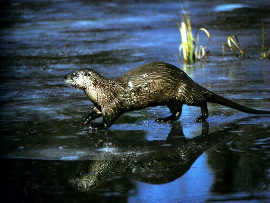 The otter was one of our rarest mammals. It declined rapidly from the 1950s to the 1970s because of dangerous pesticides and loss of riverside trees. But since then efforts to clean up our rivers has meant that the otter has now returned to every county in England!
The otter was one of our rarest mammals. It declined rapidly from the 1950s to the 1970s because of dangerous pesticides and loss of riverside trees. But since then efforts to clean up our rivers has meant that the otter has now returned to every county in England!
Living in an undisturbed stretch of river, the otter is perfectly adapted to swimming under water.
The otter is at the top of the food chains, eating mainly fish. It makes its home (holt) underneath overhanging tree roots.
A muddy bank provides an ideal place for the water vole's burrow; it is active by day, feeding on the roots and shoots of grasses, reeds, willow and other waterside plants. Once common throughout lowland Britain, this attractive vole is now declining because of habitat loss and pollution. Despite this the IUCN has classified it as Least Concern.
The water shrew and the mink are more mammals which you may find living in this habitat.
Life at the Bottom
 The riverbed is made of a fine, fertile silt with a few stones and pebbles. Plants such as curled pondweed provide oxygen and shelter for invertebrates. Some caddisfly larvae make protective damselflycases out of pieces of leaf, but other species make cases out of bits of stick, sand grains, or tiny shells; others make no case at all. The damselfly nymph (larva) lives for up to 2 years underwater and then climbs up a water plant into the air, emerging from its case as a winged adult. Caddisflies and damselflies are carnivorous insects, leeches are worms which suck the blood from vertebrates and the freshwater shrimp are scavenging crustaceans, eating decaying plant and animal material on the bottom.
The riverbed is made of a fine, fertile silt with a few stones and pebbles. Plants such as curled pondweed provide oxygen and shelter for invertebrates. Some caddisfly larvae make protective damselflycases out of pieces of leaf, but other species make cases out of bits of stick, sand grains, or tiny shells; others make no case at all. The damselfly nymph (larva) lives for up to 2 years underwater and then climbs up a water plant into the air, emerging from its case as a winged adult. Caddisflies and damselflies are carnivorous insects, leeches are worms which suck the blood from vertebrates and the freshwater shrimp are scavenging crustaceans, eating decaying plant and animal material on the bottom.
Make a list of other invertebrates you may find at the bottom of the river or amongst submerged plants.
Bird Life on the River
 Several species of bird may be found on the river, including the mallard, the most common duck. It is a ‘dabbling’ duck, feeding on the surface of the water, eating plants and small animals. The grey heron and the kingfisher are both predators. The heron stands motionless in shallow water and strikes at a passing fish or another small creature with its dagger-like bill. The brightly-coloured kingfisher dives from a perch to catch a small fish underwater. It nests in a sandy bank, excavating a long tunnel.
Several species of bird may be found on the river, including the mallard, the most common duck. It is a ‘dabbling’ duck, feeding on the surface of the water, eating plants and small animals. The grey heron and the kingfisher are both predators. The heron stands motionless in shallow water and strikes at a passing fish or another small creature with its dagger-like bill. The brightly-coloured kingfisher dives from a perch to catch a small fish underwater. It nests in a sandy bank, excavating a long tunnel.
Find out what other birds may live along a river like this one.
River Plants
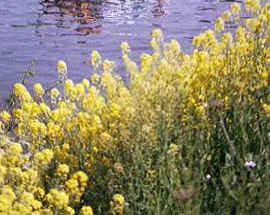 The crack willow is one of the most common trees growing along the bank. It often used to be pollarded i.e. the branches were cut back regularly to produce a supply of poles for rural industries. The willow’s roots help to stabilize the banks. Many emergent plants may be found i.e. those rooted underwater but much of their growth is above the water surface. The arrowhead is a small emergent with some leaves underwater, and the reedmace, a large example, can form a dense reedbed. Other bankside plants grow well in marshy ground, such as the yellow marsh marigold and the pink great willowherb. Plants such as curled pondweed are rooted in the bottom and remain either submerged in deep water or their leaves reach the surface.
The crack willow is one of the most common trees growing along the bank. It often used to be pollarded i.e. the branches were cut back regularly to produce a supply of poles for rural industries. The willow’s roots help to stabilize the banks. Many emergent plants may be found i.e. those rooted underwater but much of their growth is above the water surface. The arrowhead is a small emergent with some leaves underwater, and the reedmace, a large example, can form a dense reedbed. Other bankside plants grow well in marshy ground, such as the yellow marsh marigold and the pink great willowherb. Plants such as curled pondweed are rooted in the bottom and remain either submerged in deep water or their leaves reach the surface.
In what ways are these plants, and other river-dwelling species, useful to the animals of a river?
Fish
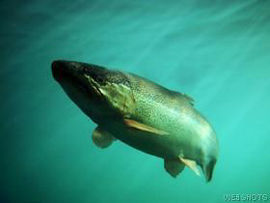 Fish have stream-lined bodies to help them glide easily through the water. The predatory pike is especially slim to help it move fast when hunting its prey. It is well-camoulflaged as it lies in wait for a smaller fish to swim into its territory, which it then chases and seizes with its large, pointed teeth. The brown trout, a favourite with anglers, and the roach are both carnivorous fish, eating small invertebrates.
Fish have stream-lined bodies to help them glide easily through the water. The predatory pike is especially slim to help it move fast when hunting its prey. It is well-camoulflaged as it lies in wait for a smaller fish to swim into its territory, which it then chases and seizes with its large, pointed teeth. The brown trout, a favourite with anglers, and the roach are both carnivorous fish, eating small invertebrates.
Can you find more examples of freshwater fish?
Credits
Image: Rivers by Joe Dunckley
Information sourced from:
The IUCN Red List of Threatened Species (2015), Arvicola amphibius [online], Available from: http://www.iucnredlist.org/details/full/2149/0 [accessed 01/08/2015].
 When it rains, some water soaks into the ground and some of it collects, forming streams and rivers that eventually flow into the sea. The water that falls as rain is constantly recycled because water can change from a liquid to a gas (a process known as evaporation) and back to a liquid again (condensation). The water from rivers, seas and oceans is turned into water vapour by the sun’s heat and by the wind. This vapour rises up into the sky and the cold air there makes the vapour condense into droplets and form clouds. These droplets grow bigger and heavier until they eventually fall as rain. This continuous movement of water is called the water cycle.
When it rains, some water soaks into the ground and some of it collects, forming streams and rivers that eventually flow into the sea. The water that falls as rain is constantly recycled because water can change from a liquid to a gas (a process known as evaporation) and back to a liquid again (condensation). The water from rivers, seas and oceans is turned into water vapour by the sun’s heat and by the wind. This vapour rises up into the sky and the cold air there makes the vapour condense into droplets and form clouds. These droplets grow bigger and heavier until they eventually fall as rain. This continuous movement of water is called the water cycle. A river is therefore a very important part of the water cycle, carrying rain water back to the sea. It can be a long journey for a raindrop. Rivers can run for many hundreds of miles. The longest river in the world is the Nile in Africa. It is 6,700km long. The longest river in Britain is the River Severn, which is 354km long.
A river is therefore a very important part of the water cycle, carrying rain water back to the sea. It can be a long journey for a raindrop. Rivers can run for many hundreds of miles. The longest river in the world is the Nile in Africa. It is 6,700km long. The longest river in Britain is the River Severn, which is 354km long.
 Eventually a river meets the sea and the place where it does is called the mouth. The last of the mud is deposited at the river’s mouth. A wide mouth is called an estuary. Some estuaries are enormous – the estuary of the Amazon is 333 kilometres wide!
Eventually a river meets the sea and the place where it does is called the mouth. The last of the mud is deposited at the river’s mouth. A wide mouth is called an estuary. Some estuaries are enormous – the estuary of the Amazon is 333 kilometres wide! Generally speaking, in Britain you can find three main types of river;
Generally speaking, in Britain you can find three main types of river; For hundreds of years we got rid of our waste into rivers and streams, but it was the growth of the industrial revolution during the nineteenth century that resulted in the rivers suffering the greatest pollution they have ever known. By the middle of the 1800s, the Thames was so polluted with raw human sewage that the stench was overpowering! Several epidemics of cholera broke out, causing much human suffering, and, of course, the effect on the river’s wildlife was devastating. The last record of a salmon was in 1833 and by the 1950s, the only fish left was the eel. Since then, a serious clean-up campaign has enabled even the salmon to return to the Thames. Strict bye-laws now control the discharge of effluent (waste discharged from a particular process) by riverside industry but modern development still presents problems. Every year, up to 11,000 tonnes of rubbish are collected from the Thames!
For hundreds of years we got rid of our waste into rivers and streams, but it was the growth of the industrial revolution during the nineteenth century that resulted in the rivers suffering the greatest pollution they have ever known. By the middle of the 1800s, the Thames was so polluted with raw human sewage that the stench was overpowering! Several epidemics of cholera broke out, causing much human suffering, and, of course, the effect on the river’s wildlife was devastating. The last record of a salmon was in 1833 and by the 1950s, the only fish left was the eel. Since then, a serious clean-up campaign has enabled even the salmon to return to the Thames. Strict bye-laws now control the discharge of effluent (waste discharged from a particular process) by riverside industry but modern development still presents problems. Every year, up to 11,000 tonnes of rubbish are collected from the Thames!
 The otter was one of our rarest mammals. It declined rapidly from the 1950s to the 1970s because of dangerous pesticides and loss of riverside trees. But since then efforts to clean up our rivers has meant that the otter has now returned to every county in England!
The otter was one of our rarest mammals. It declined rapidly from the 1950s to the 1970s because of dangerous pesticides and loss of riverside trees. But since then efforts to clean up our rivers has meant that the otter has now returned to every county in England! The riverbed is made of a fine, fertile silt with a few stones and pebbles. Plants such as curled pondweed provide oxygen and shelter for invertebrates. Some caddisfly larvae make protective damselflycases out of pieces of leaf, but other species make cases out of bits of stick, sand grains, or tiny shells; others make no case at all. The damselfly nymph (larva) lives for up to 2 years underwater and then climbs up a water plant into the air, emerging from its case as a winged adult. Caddisflies and damselflies are carnivorous insects, leeches are worms which suck the blood from vertebrates and the freshwater shrimp are scavenging crustaceans, eating decaying plant and animal material on the bottom.
The riverbed is made of a fine, fertile silt with a few stones and pebbles. Plants such as curled pondweed provide oxygen and shelter for invertebrates. Some caddisfly larvae make protective damselflycases out of pieces of leaf, but other species make cases out of bits of stick, sand grains, or tiny shells; others make no case at all. The damselfly nymph (larva) lives for up to 2 years underwater and then climbs up a water plant into the air, emerging from its case as a winged adult. Caddisflies and damselflies are carnivorous insects, leeches are worms which suck the blood from vertebrates and the freshwater shrimp are scavenging crustaceans, eating decaying plant and animal material on the bottom. Several species of bird may be found on the river, including the mallard, the most common duck. It is a ‘dabbling’ duck, feeding on the surface of the water, eating plants and small animals. The grey heron and the kingfisher are both predators. The heron stands motionless in shallow water and strikes at a passing fish or another small creature with its dagger-like bill. The brightly-coloured kingfisher dives from a perch to catch a small fish underwater. It nests in a sandy bank, excavating a long tunnel.
Several species of bird may be found on the river, including the mallard, the most common duck. It is a ‘dabbling’ duck, feeding on the surface of the water, eating plants and small animals. The grey heron and the kingfisher are both predators. The heron stands motionless in shallow water and strikes at a passing fish or another small creature with its dagger-like bill. The brightly-coloured kingfisher dives from a perch to catch a small fish underwater. It nests in a sandy bank, excavating a long tunnel. The crack willow is one of the most common trees growing along the bank. It often used to be pollarded i.e. the branches were cut back regularly to produce a supply of poles for rural industries. The willow’s roots help to stabilize the banks. Many emergent plants may be found i.e. those rooted underwater but much of their growth is above the water surface. The arrowhead is a small emergent with some leaves underwater, and the reedmace, a large example, can form a dense reedbed. Other bankside plants grow well in marshy ground, such as the yellow marsh marigold and the pink great willowherb. Plants such as curled pondweed are rooted in the bottom and remain either submerged in deep water or their leaves reach the surface.
The crack willow is one of the most common trees growing along the bank. It often used to be pollarded i.e. the branches were cut back regularly to produce a supply of poles for rural industries. The willow’s roots help to stabilize the banks. Many emergent plants may be found i.e. those rooted underwater but much of their growth is above the water surface. The arrowhead is a small emergent with some leaves underwater, and the reedmace, a large example, can form a dense reedbed. Other bankside plants grow well in marshy ground, such as the yellow marsh marigold and the pink great willowherb. Plants such as curled pondweed are rooted in the bottom and remain either submerged in deep water or their leaves reach the surface. Fish have stream-lined bodies to help them glide easily through the water. The predatory pike is especially slim to help it move fast when hunting its prey. It is well-camoulflaged as it lies in wait for a smaller fish to swim into its territory, which it then chases and seizes with its large, pointed teeth. The brown trout, a favourite with anglers, and the roach are both carnivorous fish, eating small invertebrates.
Fish have stream-lined bodies to help them glide easily through the water. The predatory pike is especially slim to help it move fast when hunting its prey. It is well-camoulflaged as it lies in wait for a smaller fish to swim into its territory, which it then chases and seizes with its large, pointed teeth. The brown trout, a favourite with anglers, and the roach are both carnivorous fish, eating small invertebrates.